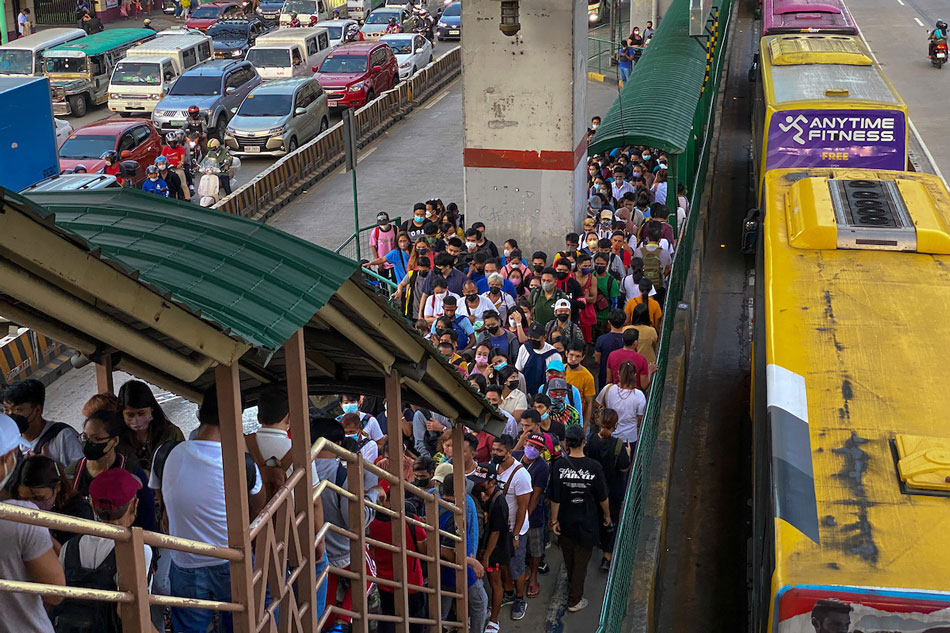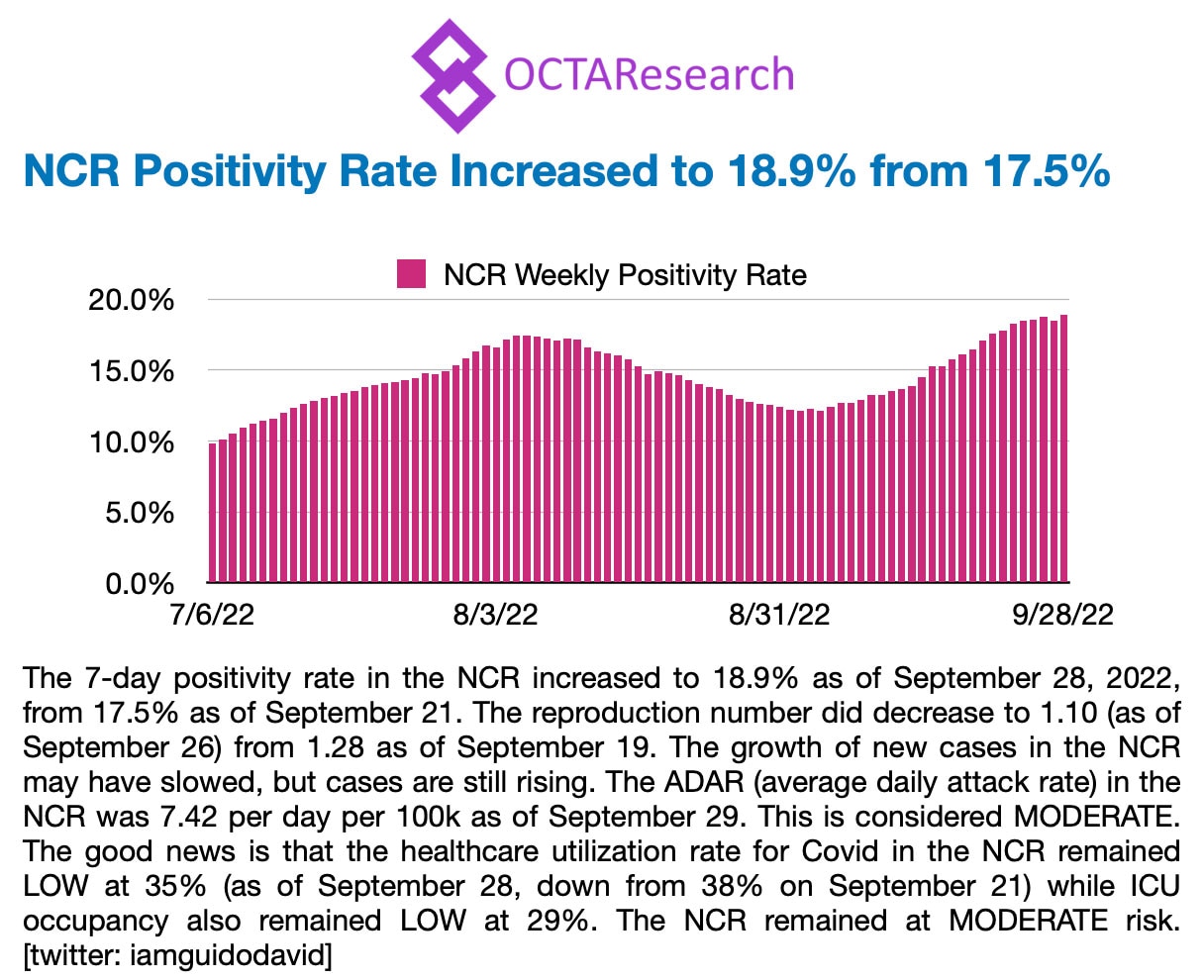Metro Manila's COVID-19 positivity rate spikes to 18.9 pct - OCTA | ABS-CBN

Welcome, Kapamilya! We use cookies to improve your browsing experience. Continuing to use this site means you agree to our use of cookies. Tell me more!
Metro Manila's COVID-19 positivity rate spikes to 18.9 pct - OCTA
Metro Manila's COVID-19 positivity rate spikes to 18.9 pct - OCTA
ABS-CBN News
Published Sep 30, 2022 04:57 PM PHT
MANILA — Metro Manila's COVID-19 positivity rate or the percentage of tests turning out positive for the virus rose this week, a think tank said Friday.
MANILA — Metro Manila's COVID-19 positivity rate or the percentage of tests turning out positive for the virus rose this week, a think tank said Friday.
According to Prof. Ranjit Rye of OCTA Research, the capital region's positivity rate increased to 18.9 percent as of Sept. 28 from the 17.5 percent logged on Sept. 21.
According to Prof. Ranjit Rye of OCTA Research, the capital region's positivity rate increased to 18.9 percent as of Sept. 28 from the 17.5 percent logged on Sept. 21.
"Nakikita natin na 'yung positivity rate napakataas po niyan. So, ibig sabihin, bukod sa kumakalat, marami sa ating mga kababayan ang likely nahawaan," he said in a televised briefing.
"Nakikita natin na 'yung positivity rate napakataas po niyan. So, ibig sabihin, bukod sa kumakalat, marami sa ating mga kababayan ang likely nahawaan," he said in a televised briefing.
"These are conservative numbers kasi nga marami pa ang hindi nagpapa-test ngayon. Mas mababa na po ang testing ngayon."
"These are conservative numbers kasi nga marami pa ang hindi nagpapa-test ngayon. Mas mababa na po ang testing ngayon."
ADVERTISEMENT
(That positivity rate is very high. It means that aside from spreading, many of our kababayans likely caught COVID-19. These are conservative numbers because many have yet to get tested. Testing has gone down.)
(That positivity rate is very high. It means that aside from spreading, many of our kababayans likely caught COVID-19. These are conservative numbers because many have yet to get tested. Testing has gone down.)
Based on the group's latest monitoring report, Metro Manila's reproduction rate or the number infected by a single COVID-19 case slightly decreased to 1.10 as of Sept. 26 from 1.28 reported on Sept. 19.
Based on the group's latest monitoring report, Metro Manila's reproduction rate or the number infected by a single COVID-19 case slightly decreased to 1.10 as of Sept. 26 from 1.28 reported on Sept. 19.
"The growth of new cases in the NCR may have slowed, but cases are still rising," OCTA Research said.
"The growth of new cases in the NCR may have slowed, but cases are still rising," OCTA Research said.
The average daily attack rate in the capital region was 7.42 per day per 100,000 as of Sept. 29, which is considered moderate. ADAR is the number of new cases over a 2-week period, divided by the population.
The average daily attack rate in the capital region was 7.42 per day per 100,000 as of Sept. 29, which is considered moderate. ADAR is the number of new cases over a 2-week period, divided by the population.
"The good news is that the healthcare utilization rate for COVID in the NCR remained low at 35 percent while ICU occupancy also remained low at 29 percent," the think tank said.
"The good news is that the healthcare utilization rate for COVID in the NCR remained low at 35 percent while ICU occupancy also remained low at 29 percent," the think tank said.
Rye said there were multiple reasons for the uptick in COVID-19 cases.
Rye said there were multiple reasons for the uptick in COVID-19 cases.
"The rising cases in the National Capital Region is driven by number 1, the presence of more contagious variants," he said. "Number 2 'yung high levels of mobility. Nag-face-to-face classes na tayo. Marami ho ang nasa labas na po."
"The rising cases in the National Capital Region is driven by number 1, the presence of more contagious variants," he said. "Number 2 'yung high levels of mobility. Nag-face-to-face classes na tayo. Marami ho ang nasa labas na po."
"Pangatlo, marami ang hindi na po nagko-comply sa minimum public health standards," he added.
"Pangatlo, marami ang hindi na po nagko-comply sa minimum public health standards," he added.
(We had face-to-face classes. Many people go out. Third, many no longer comply with minimum public health standards.)
(We had face-to-face classes. Many people go out. Third, many no longer comply with minimum public health standards.)
He warned that local authorities in Calabarzon and Central Luzon should take precautions. In the past, when COVID-19 cases are rising in Metro Manila, nearby regions also experienced the same, he added.
He warned that local authorities in Calabarzon and Central Luzon should take precautions. In the past, when COVID-19 cases are rising in Metro Manila, nearby regions also experienced the same, he added.
The Department of Health on said Thursday 13 out of 17 areas in the capital region are under "moderate" risk for COVID-19 after reporting an increase in coronavirus infections.
The Department of Health on said Thursday 13 out of 17 areas in the capital region are under "moderate" risk for COVID-19 after reporting an increase in coronavirus infections.
These include Manila, Quezon City, Las Piñas, Makati, Mandaluyong, Marikina, Muntinlupa, Parañaque, Pasay, Pasig, San Juan, Taguig, and the municipality of Pateros.
These include Manila, Quezon City, Las Piñas, Makati, Mandaluyong, Marikina, Muntinlupa, Parañaque, Pasay, Pasig, San Juan, Taguig, and the municipality of Pateros.
Based on DOH's COVID-19 tracker as of Sept. 29, Metro Manila has 11,380 active COVID-19 cases. Overall, it tallied some 1.26 million coronavirus cases, which include 13,267 fatalities.
Based on DOH's COVID-19 tracker as of Sept. 29, Metro Manila has 11,380 active COVID-19 cases. Overall, it tallied some 1.26 million coronavirus cases, which include 13,267 fatalities.
Read More:
health
OCTA Research
Ranjit Rye
Laging Handa
COVID-19
COVID19
coronavirus
Metro Manila
NCR
National Capital Region
ADVERTISEMENT
ADVERTISEMENT



